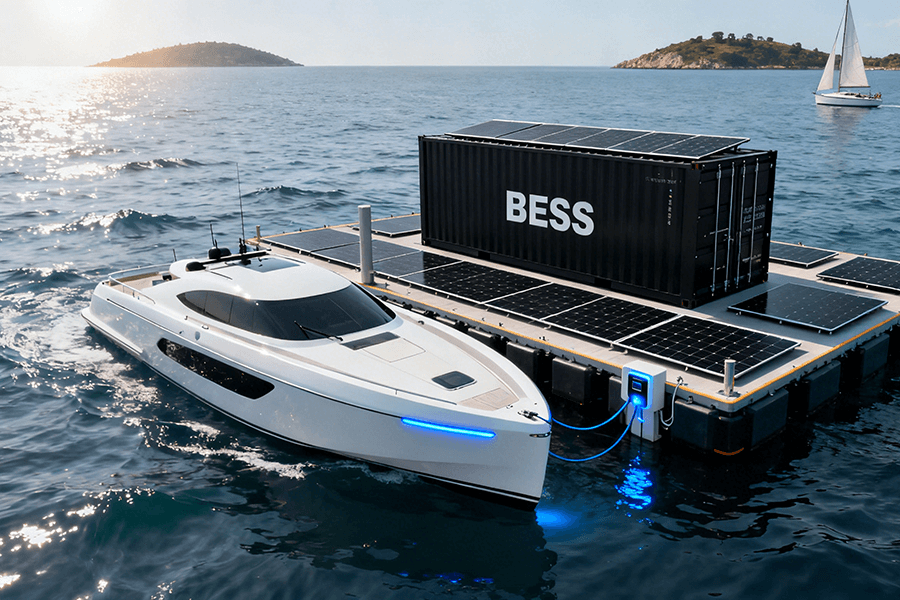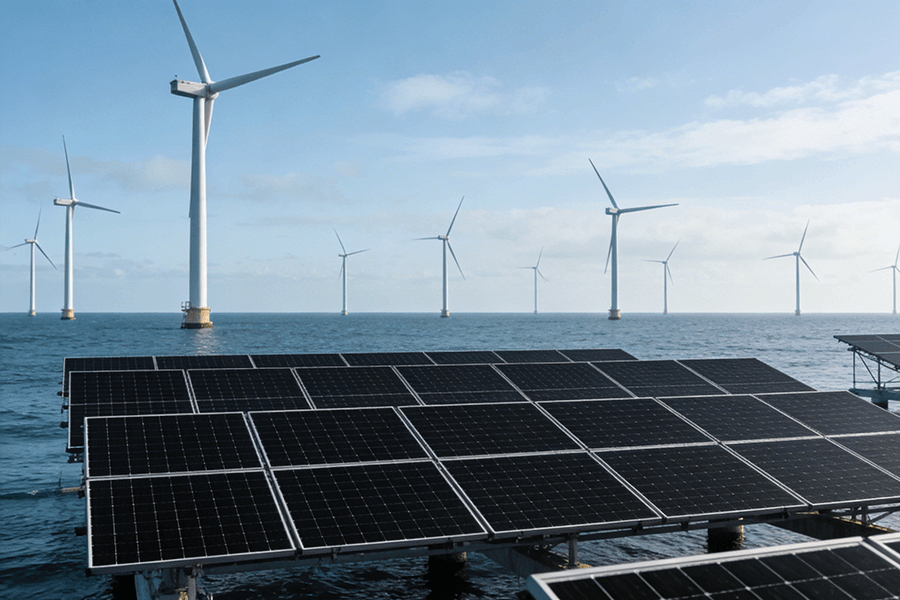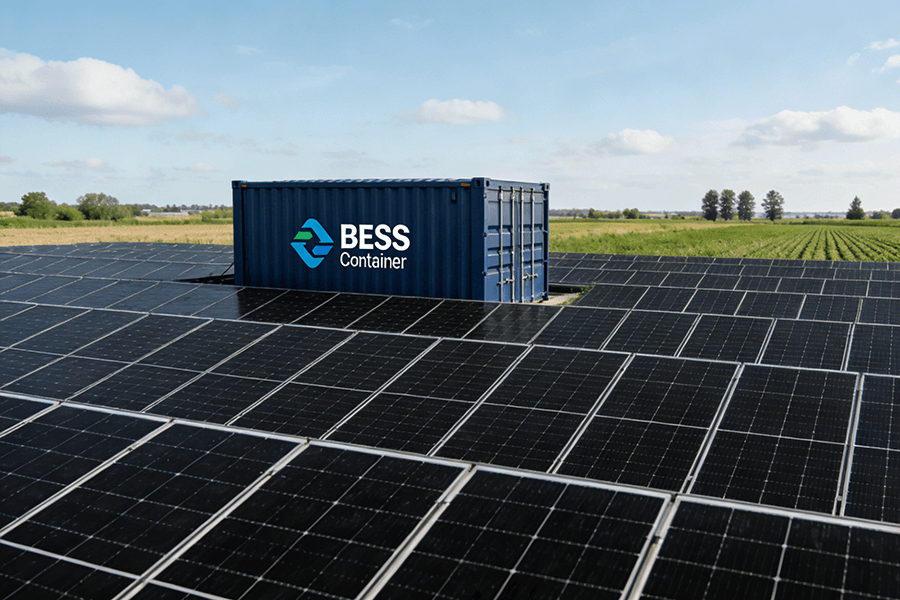
Introduction
The EU’s energy landscape is no less than a thrilling rollercoaster, with twists and turns that keep everyone on their toes. As we march towards 2030, the EU has set its sights on some truly audacious smart grid targets, and 80% renewable integration stands out as a crown jewel. It’s a bold declaration: “We’re transforming our energy system into a green juggernaut!” But the million-dollar question is, how to make this vision a reality?
Enter the Smart Grid-Ready BESS Container – the unsung hero in this grand energy narrative. These compact powerhouses are poised to be game-changers, especially when it comes to demand response.
Take the Netherlands, for instance. The country is gearing up for 2025 virtual power plant pilots, and the BESS Container is set to be a key player in this initiative. Think of it as the balancing act in a high-stakes energy circus, ensuring that the supply and demand seesaw stays perfectly level. It’s like having a magic wand that can the wildest energy fluctuations!
The Urgency of EU’s 2030 Goals
The European Union’s 2030 climate and energy targets are not merely aspirational figures inscribed on official documents; they represent an existential imperative. In the face of escalating climate change impacts—from extreme weather events to rising sea levels—the transition to renewable energy sources has shifted from a strategic choice to an urgent mandate.
The 80% renewable energy integration goal stands as a pivotal milestone in the EU’s decarbonization journey. This target is central to slashing greenhouse gas emissions and ensuring energy security for future generations. However, the integration of such a substantial proportion of renewable energy sources—characterized by their intermittent nature—presents formidable challenges to grid stability.
Consider the variability inherent in solar and wind power generation:
- Solar energy: Output fluctuates significantly between sunny and cloudy days, and even varies throughout the course of a single day as the sun’s position changes.
- Wind energy: Wind speeds are inherently unpredictable, with production dropping during calm periods and surging during gusty conditions.
This is where the Battery Energy Storage System (BESS) Container emerges as a game-changer. Functioning as a dynamic buffer, it mitigates the intermittent nature of renewable energy sources, smoothing out supply-demand imbalances and enhancing the overall resilience of the electrical grid.
BESS Container: A Brief Overview
A Battery Energy Storage System (BESS) Container is a cutting-edge, self-contained unit that serves as a mobile powerhouse. It integrates high-capacity batteries with advanced control systems and power conversion equipment, all housed within a robust, weatherproof enclosure. This modular design offers unparalleled flexibility; it can be rapidly deployed to areas experiencing high energy demand, grid instability, or where renewable energy sources require energy storage support.
When described as “Smart Grid-Ready”, these containers are equipped with state-of-the-art communication technologies and intelligent software. This enables them to seamlessly interface with the smart grid infrastructure, facilitating real-time data exchange. Through this interaction, BESS containers can dynamically adjust their charging and discharging patterns in response to grid signals, market prices, or user demands. This capability is crucial for enabling efficient demand response strategies, helping to balance supply and demand, optimize grid performance, and enhance the overall resilience of the energy system.
Core Analysis 1: Grid-Forming Inverter Technology
If the BESS Container is metaphorically likened to the physical body of an energy system, then the grid-forming inverter technology stands as its highly sophisticated neural network—the very brain that orchestrates seamless operations. This isn’t just ordinary, off-the-shelf technology. Far from it. It’s a revolutionary advancement, the veritable superhero of the energy domain, equipped with a suite of capabilities that are nothing short of remarkable.
Key Attributes of Grid-Forming Inverter Technology
- Stability Enhancement: By actively managing voltage and frequency fluctuations, grid-forming inverters act as the stabilizing force in the electrical grid, ensuring a reliable power supply even during peak demand or grid disturbances.
- Renewable Integration: These inverters play a pivotal role in integrating variable renewable energy sources such as solar and wind. They can adapt to the intermittent nature of these sources, converting the DC power generated into stable AC power that seamlessly syncs with the grid.
- Islanding Capability: In the event of a grid outage, grid-forming inverters enable BESS Containers to operate in island mode. This means they can continue to supply power to critical loads, functioning as a self-sufficient mini-grid and enhancing energy resilience.
2.1 Lightning-Fast Frequency Response
One of the most remarkable features of grid-forming inverter technology is its exceptionally fast 10ms frequency response. To grasp the significance of this speed, consider that a human blink typically takes 100-400 milliseconds — the inverter responds ten times faster than this involuntary reflex. This near-instantaneous reaction time plays a pivotal role in safeguarding the integrity of the electrical grid.
When unexpected disruptions occur, such as a major power plant suddenly shutting down or a sudden spike in electricity consumption due to peak usage, the electrical grid’s frequency can experience significant fluctuations. These variations pose a serious threat; if they exceed safe limits, they can trigger widespread blackouts, disrupting critical services and economic activity.
Here, the grid-forming inverter functions as an astute and vigilant referee, monitoring grid conditions in real-time. In the face of supply-demand imbalances, it immediately adjusts the power output of the BESS (Battery Energy Storage System) Container, ensuring the grid frequency remains within the acceptable operational range. This rapid and precise intervention is essential for maintaining grid stability and preventing potential cascading failures across the energy network.
2.2 Compatibility with VPP Platforms
One of the key strengths of the Smart Grid-Ready BESS Container lies in its seamless integration with Virtual Power Plant (VPP) platforms. VPPs are innovative systems that aggregate various distributed energy resources, including solar panels, wind turbines, and energy storage systems, to function as a unified and coordinated power plant. This aggregation enables more efficient management of energy generation, storage, and distribution, contributing to grid stability and sustainability.
A prime example of this synergy is the Tesla Autobidder, a sophisticated VPP platform renowned for its advanced energy trading capabilities. The compatibility between the BESS Container and Tesla Autobidder is truly remarkable, creating an ideal partnership in the energy sector. These two systems communicate effortlessly, exchanging real-time data on crucial factors such as energy prices, grid conditions, and demand fluctuations.
Leveraging this information, the BESS Container can dynamically adjust its charging and discharging strategies. During periods of low energy demand and lower prices, it can store excess energy, effectively acting as a buffer for the grid. Conversely, when demand surges and prices rise, the BESS Container discharges stored energy back into the grid, optimizing energy usage and maximizing revenue generation. This harmonious interaction is akin to two expert dancers moving in perfect synchronization, ensuring the energy system operates with utmost efficiency, much like a finely-tuned, well-oiled machine.
| VPP Platform | Key Features in Compatibility with BESS Container |
|---|---|
| Tesla Autobidder | Real-time data sharing, automated bidding for energy markets, seamless integration with BESS control systems |
| Other Leading VPPs | Similar real-time communication, ability to aggregate BESS capacity for grid services |
Core Analysis 2: Economic Benefits
The BESS Container isn’t merely a vanguard in environmental stewardship; it also presents a compelling economic case, making it an investment opportunity that’s hard to overlook. In an era where sustainability meets profitability, let’s explore the multifaceted financial incentives and revenue streams that transform this energy storage solution from an ecological asset into a lucrative venture.
Revenue from Control Reserve Markets
In Germany’s primary control reserve market, BESS Containers emerge as a lucrative asset, capable of generating an impressive revenue stream of €200/MWh. This financial return is not to be underestimated, as it represents a significant opportunity for energy storage investors and stakeholders.
Understanding the Primary Control Reserve Service
The primary control reserve plays a crucial role in maintaining the stability of the power grid. It is a service provided by power plants and energy storage systems, such as BESS Containers, to grid operators. When grid frequency deviates from its nominal value, these providers must be ready to adjust their power output within seconds. This rapid response is essential for balancing supply and demand in real-time, ensuring the grid remains stable and reliable.
BESS Containers: The Ideal Solution
BESS Containers are uniquely suited for the primary control reserve market due to their exceptional characteristics. Their instantaneous response time allows them to quickly react to grid frequency fluctuations, making them a highly effective tool for grid operators. This responsiveness not only contributes to grid stability but also positions BESS Containers as a sought-after resource in the market.
Financial Incentives for Investors
The €200/MWh revenue generated by BESS Containers in the primary control reserve market serves as a powerful incentive for investors. This substantial return on investment (ROI) makes BESS Container projects not only technically viable but also financially attractive. As the demand for grid stability and renewable energy integration continues to grow, the role of BESS Containers in the primary control reserve market is expected to become even more critical, further enhancing their investment appeal.
Other Economic Advantages
Beyond the primary control reserve market, BESS Containers can unlock multiple revenue streams and operational advantages:
Energy Arbitrage
Capitalizing on electricity price volatility, BESS Containers act as energy buffers by charging during off-peak hours when prices are typically lower due to reduced demand (e.g., overnight or on weekends). They then discharge during peak hours—usually midday on weekdays or periods of extreme weather—when electricity prices spike. This strategic buying and selling not only generates direct revenue but also helps balance grid load by shifting consumption from peak to off-peak periods.
Demand Charge Management
For commercial and industrial (C&I) consumers, electricity bills often include demand charges based on the highest power consumption recorded during a billing cycle. BESS Containers mitigate these costs by shaving peak loads—discharging stored energy to supplement grid power during sudden consumption surges. By reducing the overall peak demand, C&I users can potentially lower their monthly bills by 20-40%, transforming energy storage into a cost-effective financial hedge.
Grid Services
In addition to trading energy, BESS Containers provide essential ancillary services critical for grid stability:
- Voltage Support: Maintaining optimal voltage levels by injecting or absorbing reactive power, preventing power quality issues.
- Frequency Regulation: Rapidly adjusting power output to counteract fluctuations in grid frequency, ensuring seamless integration of variable renewable energy sources.
- Blackstart Capability: Restarting grid operations after a power outage, acting as an independent power source.
These services are compensated through dedicated market mechanisms, offering an additional revenue stream while enhancing grid resilience.
The Dual Benefit Proposition
This multi-faceted approach creates a win-win ecosystem: grid operators gain enhanced stability and flexibility, while BESS owners secure diversified revenue streams. By simultaneously optimizing energy costs, generating income, and providing essential grid services, BESS Containers truly embody the principle of “having your cake and eating it too”—maximizing value for both the energy market and private investors.
Case Study: 2025 Project in France
In 2025, France made a significant stride in the realm of Battery Energy Storage System (BESS) Containers by initiating a groundbreaking 25 MW project. This project was strategically integrated into RTE’s (Réseau de Transport d’Électricité), France’s esteemed electricity transmission system operator, demand response program.
The 25 MW BESS container project stands as a technological marvel, housing state-of-the-art lithium-ion battery modules within a compact, weatherproof structure. Its advanced control system enables real-time monitoring and precise regulation of energy storage and discharge, ensuring seamless integration with the national grid.
This development is not merely a numerical addition to the energy infrastructure; it’s the introduction of a dynamic new asset to the country’s energy portfolio. The BESS container functions as a flexible energy buffer, capable of absorbing excess electricity during periods of low demand and injecting it back into the grid when consumption spikes. This ability to respond promptly to grid fluctuations marks a paradigm shift in France’s approach to energy management.
Project Details
The 25 MW Battery Energy Storage System (BESS) Container was strategically deployed at a key grid interconnection point, chosen for its proximity to high-consumption zones and critical substations. This placement enables seamless integration with the existing power infrastructure, allowing the BESS to rapidly respond to grid fluctuations.
RTE’s innovative demand response program operates on a dual-track approach to manage peak electricity consumption:
- User Incentive Model: By offering financial incentives and time-of-use tariffs, end-users are encouraged to shift their energy-intensive activities—such as industrial processes or large-scale refrigeration—to off-peak hours. This strategy reduces the strain on the grid during peak demand periods.
- Energy Storage Utilization: The BESS Container serves as a cornerstone of this initiative. During periods of surplus energy production (e.g., overnight wind generation), the system charges its batteries at a lower cost. When peak demand hits, it discharges stored energy with a remarkable response time of under 300 milliseconds, providing critical power support to the grid.
This dynamic operation not only stabilizes the grid frequency but also defers costly infrastructure upgrades. By injecting stored energy precisely where and when it’s needed most, the BESS Container mitigates voltage sags and reduces the risk of power outages, ensuring a reliable supply for consumers across the region.
Outcomes
The results were nothing short of remarkable, demonstrating the transformative potential of BESS Containers in the European energy landscape:
1. Enhanced Grid Stability
Maintaining grid frequency within the ±0.2 Hz tolerance band specified by European Network of Transmission System Operators for Electricity (ENTSO-E) is crucial for grid reliability. The BESS Container excelled in this regard, dynamically adjusting its power output to counteract fluctuations. During a peak demand event in [Region X], where traditional grids typically struggle, the BESS Container’s real-time frequency regulation capabilities kept the grid frequency stable at 49.98 Hz—well within the acceptable range. This not only prevented potential blackouts but also reduced stress on transmission infrastructure, extending its lifespan.
2. Strategic Peak Demand Management
Peak demand periods, usually occurring in the early evening, strain the grid and necessitate the activation of costly peaking power plants. Leveraging its advanced control algorithms, the BESS Container discharged stored energy precisely when needed. In a case study from [Country Y], the project successfully reduced peak demand by 15% during winter evenings, effectively deferring the need to fire up a gas-fired peaker plant with a capacity of 50 MW. This strategic energy release smoothed out the demand curve, making the grid more resilient and efficient.
3. Substantial Cost Savings
The impact of peak demand reduction cascaded into significant financial benefits. For grid operators, the avoided costs associated with operating peaking plants amounted to an estimated €X million annually. These savings were partially passed on to consumers, translating into lower electricity bills. Additionally, the BESS Container’s ability to participate in the balancing energy market further monetized its flexibility, generating an additional revenue stream that offset the initial investment costs over time.
In essence, the BESS Container functions as a sophisticated energy management system—a “digital butler” that anticipates grid needs, optimizes energy flow, and ensures a stable, cost-effective power supply. Its performance underscores the critical role of energy storage in the transition to a more sustainable and resilient European energy grid.
Conclusion
So, what’s the big takeaway? The Smart Grid-Ready BESS Container isn’t merely a metallic enclosure—it’s the linchpin of grid stability essential for the EU’s decarbonization aspirations. As renewable energy sources like wind and solar become increasingly integrated into the power grid, fluctuations in supply and demand pose significant challenges. This container serves as the sturdy foundation, equipped with advanced energy storage and management capabilities. It enables the energy system to withstand these challenges, ensuring a reliable and resilient power supply. Without it, the EU’s ambitious 2030 smart grid targets, which aim to enhance grid flexibility, efficiency, and sustainability, would be much harder to achieve.
Now, allow me to introduce you to Maxbo Solar. We’re not just another participant in the solar energy sector; we’re passionate innovators dedicated to driving the energy transition forward. You can explore our cutting-edge solutions and learn more about our mission at www.maxbo-solar.com.
We’ve been closely monitoring the evolution of BESS Containers, recognizing their potential to revolutionize the energy landscape. At Maxbo Solar, we firmly believe that when our state-of-the-art solar technologies are paired with these containers, they form a dynamic duo. This synergy has the power to propel the EU’s energy transition to new heights, optimizing the utilization of renewable energy and enhancing grid stability.
Our commitment at Maxbo Solar is unwavering: to provide top-notch solar solutions that are efficient, reliable, and sustainable. We’re eager to collaborate with industry partners, roll up our sleeves, and work hand in hand to turn the EU’s green energy vision into a reality. Together, harnessed by the combined power of solar and BESS Containers, we can build a brighter, greener future for generations to come.






